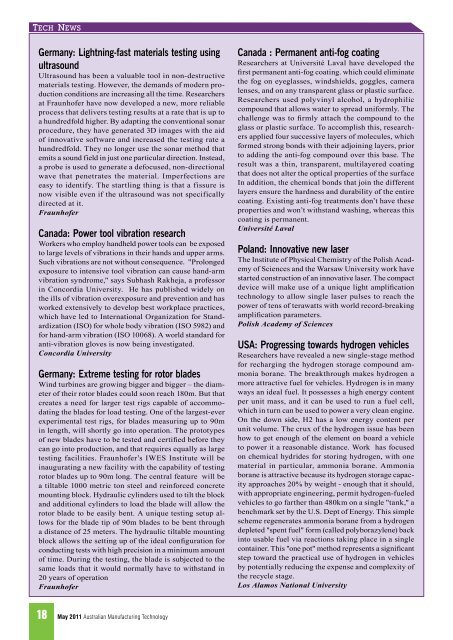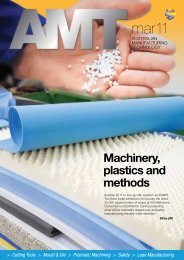May 2011 - Amtil
May 2011 - Amtil
May 2011 - Amtil
Create successful ePaper yourself
Turn your PDF publications into a flip-book with our unique Google optimized e-Paper software.
Tech News<br />
Germany: Lightning-fast materials testing using<br />
ultrasound<br />
Ultrasound has been a valuable tool in non-destructive<br />
materials testing. However, the demands of modern production<br />
conditions are increasing all the time. Researchers<br />
at Fraunhofer have now developed a new, more reliable<br />
process that delivers testing results at a rate that is up to<br />
a hundredfold higher. By adapting the conventional sonar<br />
procedure, they have generated 3D images with the aid<br />
of innovative software and increased the testing rate a<br />
hundredfold. They no longer use the sonar method that<br />
emits a sound field in just one particular direction. Instead,<br />
a probe is used to generate a defocused, non-directional<br />
wave that penetrates the material. Imperfections are<br />
easy to identify. The startling thing is that a fissure is<br />
now visible even if the ultrasound was not specifically<br />
directed at it.<br />
Fraunhofer<br />
Canada: Power tool vibration research<br />
Workers who employ handheld power tools can be exposed<br />
to large levels of vibrations in their hands and upper arms.<br />
Such vibrations are not without consequence. "Prolonged<br />
exposure to intensive tool vibration can cause hand-arm<br />
vibration syndrome," says Subhash Rakheja, a professor<br />
in Concordia University. He has published widely on<br />
the ills of vibration overexposure and prevention and has<br />
worked extensively to develop best workplace practices,<br />
which have led to International Organization for Standardization<br />
(ISO) for whole body vibration (ISO 5982) and<br />
for hand-arm vibration (ISO 10068). A world standard for<br />
anti-vibration gloves is now being investigated.<br />
Concordia University<br />
Germany: Extreme testing for rotor blades<br />
Wind turbines are growing bigger and bigger – the diameter<br />
of their rotor blades could soon reach 180m. But that<br />
creates a need for larger test rigs capable of accommodating<br />
the blades for load testing. One of the largest-ever<br />
experimental test rigs, for blades measuring up to 90m<br />
in length, will shortly go into operation. The prototypes<br />
of new blades have to be tested and certified before they<br />
can go into production, and that requires equally as large<br />
testing facilities. Fraunhofer’s IWES Institute will be<br />
inaugurating a new facility with the capability of testing<br />
rotor blades up to 90m long. The central feature will be<br />
a tiltable 1000 metric ton steel and reinforced concrete<br />
mounting block. Hydraulic cylinders used to tilt the block<br />
and additional cylinders to load the blade will allow the<br />
rotor blade to be easily bent. A unique testing setup allows<br />
for the blade tip of 90m blades to be bent through<br />
a distance of 25 meters. The hydraulic tiltable mounting<br />
block allows the setting up of the ideal configuration for<br />
conducting tests with high precision in a minimum amount<br />
of time. During the testing, the blade is subjected to the<br />
same loads that it would normally have to withstand in<br />
20 years of operation<br />
Fraunhofer<br />
Canada : Permanent anti-fog coating<br />
Researchers at Université Laval have developed the<br />
first permanent anti-fog coating. which could eliminate<br />
the fog on eyeglasses, windshields, goggles, camera<br />
lenses, and on any transparent glass or plastic surface.<br />
Researchers used polyvinyl alcohol, a hydrophilic<br />
compound that allows water to spread uniformly. The<br />
challenge was to firmly attach the compound to the<br />
glass or plastic surface. To accomplish this, researchers<br />
applied four successive layers of molecules, which<br />
formed strong bonds with their adjoining layers, prior<br />
to adding the anti-fog compound over this base. The<br />
result was a thin, transparent, multilayered coating<br />
that does not alter the optical properties of the surface<br />
In addition, the chemical bonds that join the different<br />
layers ensure the hardness and durability of the entire<br />
coating. Existing anti-fog treatments don’t have these<br />
properties and won’t withstand washing, whereas this<br />
coating is permanent.<br />
Université Laval<br />
Poland: Innovative new laser<br />
The Institute of Physical Chemistry of the Polish Academy<br />
of Sciences and the Warsaw University work have<br />
started construction of an innovative laser. The compact<br />
device will make use of a unique light amplification<br />
technology to allow single laser pulses to reach the<br />
power of tens of terawatts with world record-breaking<br />
amplification parameters.<br />
Polish Academy of Sciences<br />
USA: Progressing towards hydrogen vehicles<br />
Researchers have revealed a new single-stage method<br />
for recharging the hydrogen storage compound ammonia<br />
borane. The breakthrough makes hydrogen a<br />
more attractive fuel for vehicles. Hydrogen is in many<br />
ways an ideal fuel. It possesses a high energy content<br />
per unit mass, and it can be used to run a fuel cell,<br />
which in turn can be used to power a very clean engine.<br />
On the down side, H2 has a low energy content per<br />
unit volume. The crux of the hydrogen issue has been<br />
how to get enough of the element on board a vehicle<br />
to power it a reasonable distance. Work has focused<br />
on chemical hydrides for storing hydrogen, with one<br />
material in particular, ammonia borane. Ammonia<br />
borane is attractive because its hydrogen storage capacity<br />
approaches 20% by weight - enough that it should,<br />
with appropriate engineering, permit hydrogen-fueled<br />
vehicles to go farther than 480km on a single "tank," a<br />
benchmark set by the U.S. Dept of Energy. This simple<br />
scheme regenerates ammonia borane from a hydrogen<br />
depleted "spent fuel" form (called polyborazylene) back<br />
into usable fuel via reactions taking place in a single<br />
container. This "one pot" method represents a significant<br />
step toward the practical use of hydrogen in vehicles<br />
by potentially reducing the expense and complexity of<br />
the recycle stage.<br />
Los Alamos National University<br />
18 <strong>May</strong> <strong>2011</strong> Australian Manufacturing Technology





